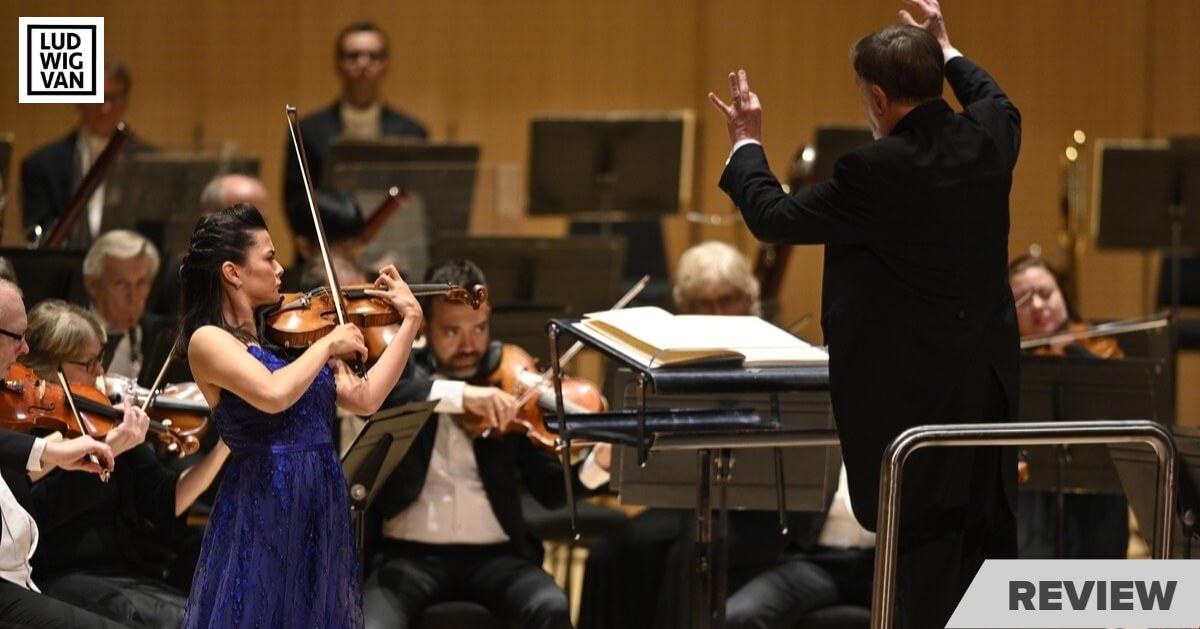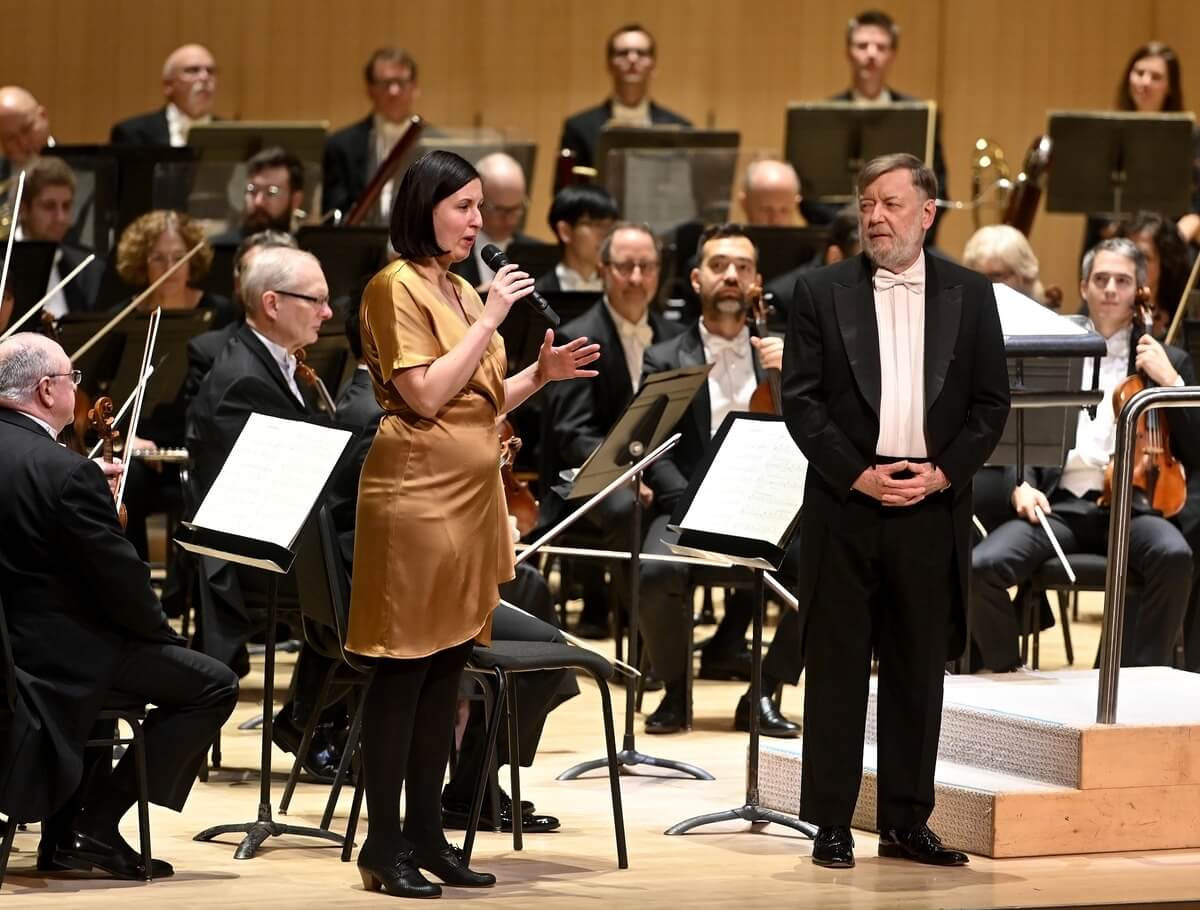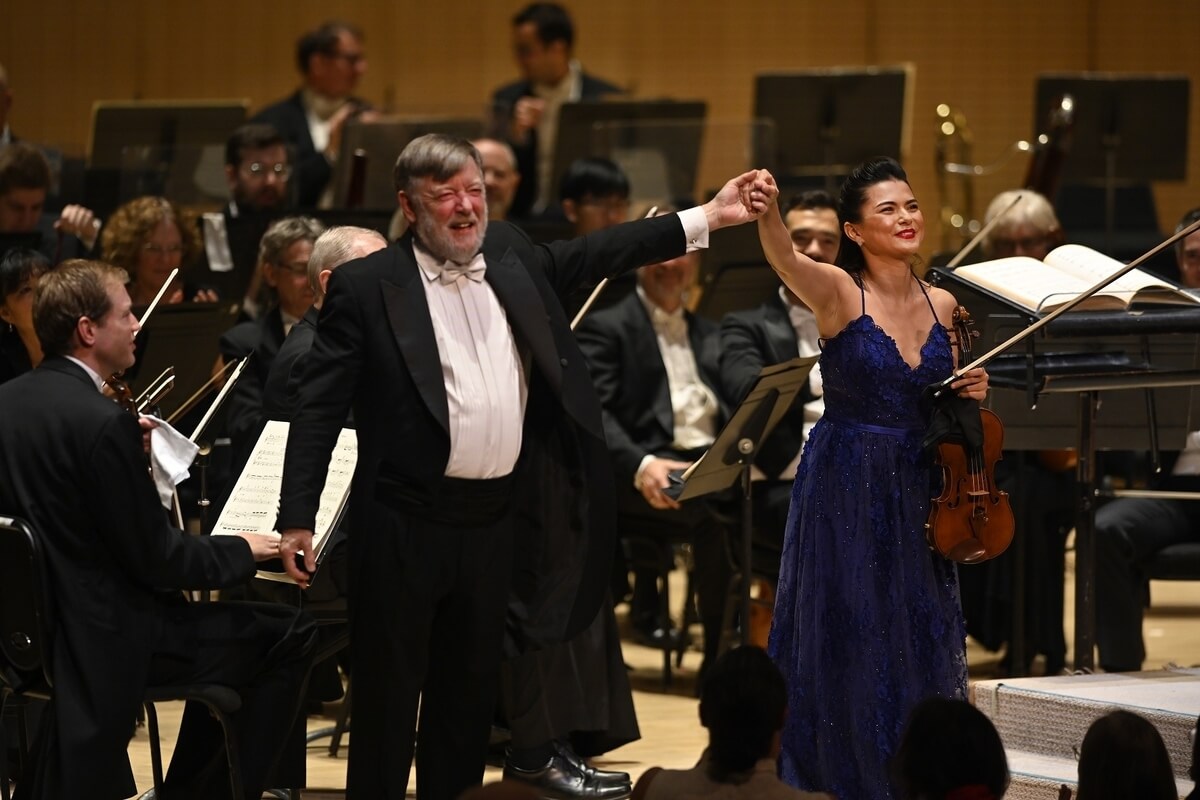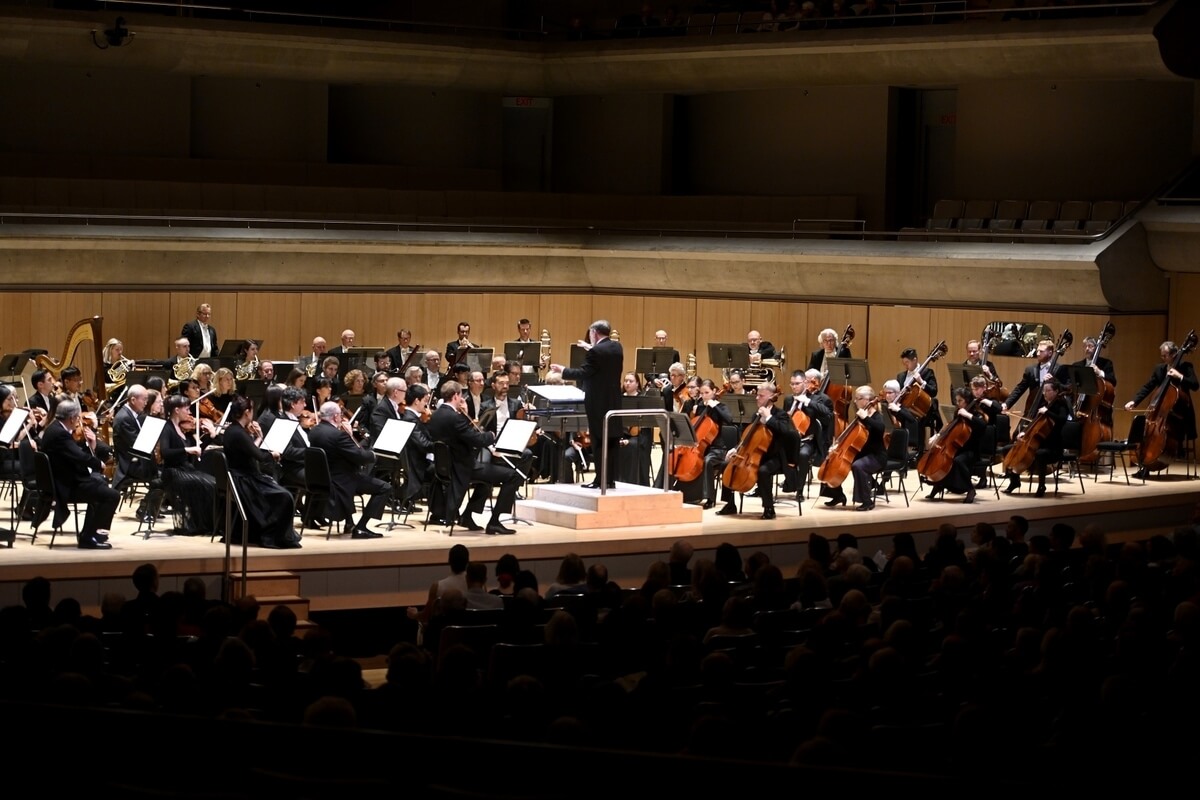Sir Andrew Davis at his interpretive best, and powerful performances from violin soloist Karen Gomyo and the TSO, create a memorable night of Russian masters and a Canadian composer’s premiere.

Emilie LeBel: unsheltered; Prokofiev: Violin Concerto No. 1; Shostakovich: Symphony No. 10. Sir Andrew Davis, conductor; Karen Gomyo, violin; Toronto Symphony Orchestra. Roy Thomson Hall, 8 p.m., Nov. 13, 2019.
It was a snowy Wednesday night, but a hot blockbuster concert nevertheless for the TSO at Roy Thomson Hall — one you wouldn’t have wanted to miss regardless of the weather. Many braved a blizzard to see violinist Karen Gomyo return, and by every account the audience couldn’t get enough of her, but perhaps most welcome last night was the return of conductor laureate Sir Andrew Davis, directing another triumph as a fitting encore to last week’s opera-in-concert production of Massenet’s Thaïs.
Equally important however was the sad fact that there was only one performance of Davis Conducts Russian Masters in Toronto, the culminating stop in a quick three-city tour of this adventurous program which included concerts in Ottawa and Montreal. Here again was Sir Andrew, spearheading a concert of such contrary dimensions with the controversial and complex Shostakovich Tenth Symphony in E minor complemented by Prokofiev’s early lyrical masterpiece, the First Violin Concerto in D. Rounding it off was the world première of unsheltered, an at-once soothing yet unsettling tone poem by one of my favourite Canadian composers, Émilie LeBel.
LeBel wrote unsheltered at her home in the Edmonton area while much of the region of Northern Alberta was blanketed in forest fire smoke. LeBel turned the occasion to one of meditation, contemplating the unfolding of our two most prominent global challenges, the migrant crisis and the climate crisis, and fused them together into a stasis of coherent expression.
The result was very much a success in her ten-minute testimony to the impact of displacement and the loss of security when human shelter is torn away, whether by force of politics or the shortsightedness of anthropogenic climate change.
The leitmotiv of anxiety played a premium role throughout: quiet glissandi in both strings and then trombones smokily wafted amid a hazy interior texture. All was quiet but unsettling — the perfect avatar to the concert’s second half. As an eerie calm stood proxy for the disquieting silence LeBel must have felt beholding the forest fire’s choking clouds through her window with a view of only a few metres, I had to wonder with the periodic tinpot clatter of percussion sounds if she was evoking something more.
It seemed that unsheltered wasn’t written to inspire action or relief from our current paralysis in the face of global crises, but rather it read as a confession of sorts, one of anxious, slow unfolding, as though we had been caught and paralyzed by our own demonstrable foolishness and now we are paying the price.

In between LeBel’s quiet tone poem and Shostakovich’s dramatic masterpiece to come, glittered Prokofiev’s unique Violin Concerto in D, the product of a young composer who in 1917 was producing works with uncommon speed and inventive proficiency (Classical Symphony, Scythian Suite and more).
I love this work for its surfeit of rhythm, tonal polish and extended lyricism, a signature piece of early Prokofiev that doesn’t scrimp when placing virtuoso demands on the violin soloist. There are glowing harmonics throughout the first movement, necessitating the soloist to play with quiet assurance and great nuance even in the face of some intermittent double and triple stopping.
The opening melody is sweetened with an interesting backstory. Prokofiev is known to have composed it while at a retreat in the Caucasus mountains where he had secretly fallen in love with Nina Meshcherskaya. It is an interesting melody both on that account and for its rare contentment from a young composer who was known for writing more brash, motoric elements than lyrical ones.
Karen Gomyo played the entire concerto with all the attention to detail its diverse score required. Last night was a powerful performance, scintillating at times in both virtuoso accuracy and resplendent intonation choices but always with a disciplined tone, burnished at the edges with an enviable roundedness never lacking in control. Gomyo is a special violinist who understands exactly what she is playing, never settling for substandard interpretation in place of the hard work required to sculpt a performance of considerable feeling. Her lovely, smooth solo encore of an Astor Piazzolla slow tango warmed up a chilly November night considerably.

After a solid first half from the TSO it was time for the main event, Shostakovich’s brooding masterpiece, the Tenth Symphony in E minor. It has been claimed that Shostakovich wrote the Tenth right after Stalin’s death as a gloomy angst-filled condemnation of the most repressive era in Soviet, or perhaps, all of Russian history. However, many have called the Stalin program into question, especially Elizabeth Wilson, who is one of the most perceptive of Shostakovich’s biographers and analytical scholars.
In short, Wilson and many others rightly tell us that unless a specific meaning was explicitly indicated by Shostakovich either in his score or through his letters, it is somewhat difficult to grasp his programmatic intentions. The central difficulty with listening to the majority of Shostakovich’s music is that the more one hears, the more one becomes mired in the composer’s psychologically complex persona, one inextricably intercalated with the tragedy of his time, and the deepest scars of a man expressed in some of the most grievous, unremitting musical terms in the history of all the arts.
That the second-movement scherzo should form the rough basis of a musical parodistic portrait of Stalin is not unlikely but nor is it clearly plausible either. What we do know is that two important themes permeate the four movements throughout, one of which is the DSCH theme, which spells out the approximate letters of Shostakovich’s name via the musical notes D-E flat-C-B in German musical notation, and that it also shows up in his Eighth String Quartet.
The second theme comprises the letters taken from the name of his former student Elmira, with whom he had fallen in love well after she took lessons from him, but at an earlier point in his life and during a very dark time. Together, these two themes permutate and combine into an intensity of multiplicitous contrapuntal combinations, effectively taking over every musical texture.
These personal elements imbue each movement with either a haunting nostalgia in moments of the quietest eerie repose, or a frenetic chaos that seems to shred the orchestral texture to pieces in only the most harrowing terms.
The orchestra’s brilliance was inestimable throughout, conspicuously in the technically brutal second and fourth movements. Never did the brass sound so absolutely perfect in rounded tone and spirited élan, an obligatorily specific Shostakovichian sound that must resonate both as bitterly jaded, albeit brightly pungent with suffused sarcasm.

And the horn section — they threw everything they had into creating some of the most startling and acoustically brilliant moments of the evening, exuding a reverb off the left wall into a centroid of spectral quality the likes of which I have not heard in that hall in a long time. The winds presented focused, pointed timbres throughout, from elegant bassoon to a snarling contra. Finally, I hope everyone noticed the difficult piccolo line and how brilliantly played it was.
The atmospheric “Nocturne” third movement, where the strings glowed in some of the most beautifully lyrical passage work I have ever heard in this repertoire, was a fine summation of Shostakovich’s most tender feeling, pent up and awaiting release for so long in his tortured life.
The TSO’s searing performance of the chilling finale offered a horrifying depiction of the horrors Shostakovich witnessed, decrying the human tragedy that was the totalitarian state of the Soviet Union during that era. But it was also possible to read the symphony’s conclusion as a Shostakovich’s triumph in outliving Stalin, surviving to tell the tale of what he witnessed. Perhaps this is why the DSCH theme returns so loudly in the brass in the final moments. It is a convincing statement from a composer who couldn’t be silenced.
Regardless of what any of us believes about the Tenth, this TSO presentation featured Sir Andrew Davis conducting at his interpretive best, combining the symphony’s several possible meanings into an intelligible whole. No wonder it received an instant standing ovation.
Shostakovich’s technical and contrapuntal mastery, combined with his enviable compositional control throughout, demanded a deft touch from everyone on stage in every bar of music. Davis and the TSO stopped at nothing to carefully explain each motive in exhaustive musical terms, and every moment of bitter hue and caustic colour in what has to be described as an epic leap-to-your-feet performance.
We need more Shostakovich symphonies to be programmed right away. For example, the last concert in which we heard the Seventh live by the TSO was eleven years ago, the Tenth nearly eight years ago. It’s time — the TSO has whetted our appetite, and Wednesday night left us ready for more.
#LUDWIGVAN
Want more updates on classical music and opera news and reviews? Follow us on Facebook, Instagram or Twitter for all the latest.
- SCRUTINY | Opera Atelier’s Film Of Handel’s ‘The Resurrection’ A Stylish And Dramatic Triumph - May 28, 2021
- HOT TAKE | James Ehnes And Stewart Goodyear Set The Virtual Standard For Beethoven 250 - December 15, 2020
- SCRUTINY | Against the Grain’s ‘Messiah/Complex’ Finds A Radical Strength - December 14, 2020



